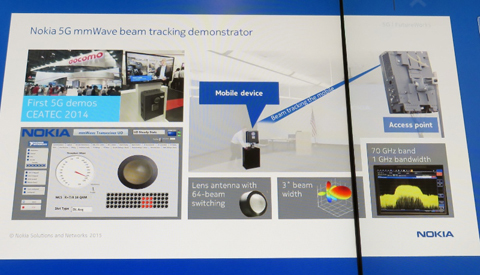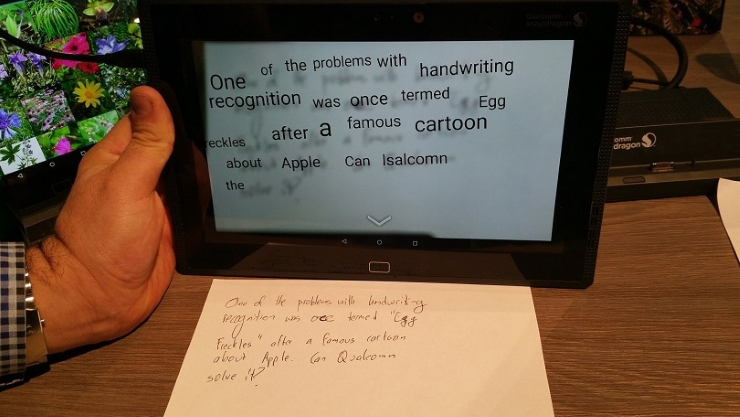MWC-2015: applicants for the role of 5G and a number of interesting innovations

We are invariably interested in news and trends in the field of cellular communication - and the topic of 5G, of course, is one of the top priorities from the point of view of the development strategy of the telecom industry. We have repeatedly written in the blog about what features should be inherent in 5G, what could be the features of the technical implementation . At the recently held exhibition MWC-2015, a number of companies presented their developments claiming to be the future 5G. Of particular interest is the fact that these are no longer theoretical arguments, but quite concrete experimental solutions. Some of them may well become a new industry standard in a few years. We are sharing with you the translation of a small review of technologies that claim to be 5G.
This year at the exhibition there were quite often demonstration stands with the inscription 5G. Many have tried to give their decision for 4G or LTE as the “heir”, as if this is already a resolved issue. This situation speaks of the genuine interest of the industry, and demand generates supply from manufacturers. An inexperienced visitor could even have the feeling that a little more - and 5G would be put into commercial operation. Alas, it is not.
Formally, the requirements for 5G technology will be developed by the ITU (International Telecommunication Union) not earlier than 2017. And it is unlikely that the final specification, like the first network that satisfies it, will appear before 2020. All the technologies presented at the exhibition are more likely to claim to be only a part of 5G or some kind of transitional option. This includes the use of unlicensed parts of the spectrum (for example, the millimeter range), and the aggregation of licensed and unlicensed ranges, and LTE-Advanced with Wi-Fi, and all sorts of ways to increase the intelligence, reliability and security of the network.
')
Meanwhile, NGMN (Next Generation Mobile Networks) alliance published the “5G White Paper” document, which highlights various features of the future technology that many manufacturers want to realize. And apparently, much of what is described in the document begins to take its first shape.
The most interesting technologies demonstrated at the exhibition were presented by major manufacturers of network infrastructure: Alcatel-Lucent, Ericsson and Nokia. Almost all vendors are unanimous in the assumption that 5G will provide a thousandfold increase in network bandwidth, so that it will be possible to connect 1000 times more devices. Of course, this does not mean that users will be able to download information 1000 times faster than today, but in general, the mobile Internet should be much faster. The process of establishing a connection should also speed up noticeably. The idea is that the device quickly receives information and then disconnects from the network.

Such a solution will certainly require a more dense placement of cells and new network configurations. A number of companies, including Intel, have shown their options for increasing network density.
A group of other technologies involves the use of a wider frequency range. Manufacturers propose to use both licensed frequencies, where LTE and previous technologies already live, as well as unlicensed ones. For example, frequencies from the 2.4 and 5 GHz bands, often used in Bluetooth and Wi-Fi. Often it is proposed to capture the range of 6 GHz (centimeter). Such solutions have been proposed by all major manufacturers of radio equipment, and even by research groups like IMEC.
The overwhelming majority of players agree that in 5G, an imperceptible for user transition between licensed and unlicensed spectra will be realized. For example, the Wireless Broadband Alliance introduced the Next Generation Hotspot technology (using Wi-Fi Aliance Passpoint certification). Visitors to the exhibition who had SIM-cards of certain networks could even connect to these access points. At the same time there was a "seamless" switching between LTE and Wi-Fi.
SK Telecom has demonstrated a new radio access technology, providing peak performance of 7.55 Gbit / s at 28 GHz.

A company representative said that they are guided by frequencies above 6 GHz, because this part of the spectrum is already used by WiGig, and the underlying frequencies are painted according to the requirements of 3GPP. According to SK Telecom, the key feature of 5G will be the use of a wide, continuous band of frequencies. However, high frequencies have worse permeability and coverage compared to 4G, therefore relatively low frequencies will need to be used.
The company plans to focus on seamless switching between LTE-Advanced and any other new technology. Most likely, for the sake of better network management, they use the capabilities of Network Function Virtualization (NFV) in their solution. SK Telecom also plans to build a test network based on the 5G prototype in 2018, and the technology is set to launch its final launch in 2020.

Nokia has swept as much as a 10,000-fold (!) Increase in network performance. Their technology involves the use of three levels of cells: macro-cells, then a more dense level, and finally ultra-dense, probably using micro cells. For the most part, it uses the 6 GHz band. According to Nokia, during emulation, the transfer rate was reached at the level of "several gigabits per session."
Also on the Nokia booth a system based on a phased array antenna using the 70 GHz band was demonstrated. A high directional antenna simultaneously held 64 beams, each 3 degrees wide. It was very interesting to observe the movements of the structure.

Ericsson showed a number of interesting exhibits. For example, it was possible to see how a mobile device downloads data at a speed of 5 Gbit / s through a promising base station using beamforming. According to the company, 5G will not be some kind of "explosive" technology. Rather, it will be a combination of different solutions implemented in stages. For example, LTE will be part of 5G, as well as technologies using unlicensed portions of the spectrum.
According to Ericsson, an important driving factor is the increasing use of M2M technologies (machine-to-machine) and the evolution of the Internet of things. Their implementation will require a large amount of analytics and behavioral forecasting, increasing reliability, adaptability and network coverage, as well as reducing delays. This is very important for tasks such as ensuring the availability of robotic cars, remote surgery and other remote work.
Curiously, Qualcomm did not glue the 5G nameplate onto the exhibits. They explained this by saying that many of their new solutions could be a further development of LTE. In particular, the company is evaluating options for using both traditional licensed spectrum bands and unlicensed (LTE-U), as well as combining LTE and Wi-Fi bands, planning to use all these features in their future LTE-Advanced modems. Qualcomm also believes that 5G will be introduced gradually and gradually, as a result, we will come to a unified platform that includes new varieties of LTE, Wi-Fi and 5G itself. Also, the platform will involve the use of both traditional base stations and a large number of small cells.
Even in Qualcomm believe that it is necessary to focus on a wide range of possible applications, and not just to increase bandwidth or network capacity. With the development of the Internet of things, 5G will have to ensure the simultaneous operation of a huge number of devices and support new services and enterprises. The concept of an “endless network” is also worthy of interest, when user devices using cognitive technologies or machine learning are chosen from many possible ways to connect.
Interesting technology and innovation
The exhibition featured many interesting gadgets and technologies. Some of us liked it so much that we decided to mention them in this post.
Unlocking the smartphone with a look . Fujitsu managed to make a very compact iris scan module that allows you to unlock a smartphone, just by looking at it. To do this, you do not need to bring the device close to the face, rather a normal distance. The recognition process itself takes one second. The primary scanning procedure, when the device “remembers” the retina pattern, lasts about 10 seconds, while the LED and the infrared camera are activated. The technology is intended not so much to improve safety (although why not?), But for greater user comfort. For example, in order not to take off gloves in winter or in other cases when for some reason it is not convenient to unlock manually.

Hours from which the child can call in case of trouble . All parents will appreciate this idea: a wristwatch with a cellular communication module, from which you can call up to five phone numbers just by pressing a button. The device is called FiLIP, it can use GPS, Wi-Fi and base stations to determine its location, so that parents can track their children on the map on their smartphone.

Handwriting recognition by mobile gadgets . Qualcomm's Zeroth project is to use “deep learning neural networks” to teach mobile devices to “think” nonlinearly, vaguely, as people do. In short, based on several key characteristics, the system tries to describe something entirely. And then they are interpreted to restore the image described.

As you can see, the industry does not yet have any unanimous opinion regarding the future technology / technology package, which in the future will find the “5G” label. There are not even established leaders, about which one could say that one of them will “settle down” in our smartphones in five years. Yes, and the rush to develop, at first glance, is also not observed. We will monitor the situation and inform you about interesting updates.
Source: https://habr.com/ru/post/255229/
All Articles